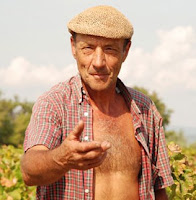 |
| Nathan Waks oiling his cello with Grenache: www.kilikanoon.com.au |
You've guessed it... "aka further adventures from the World Grenache Competition..." held in France a few weeks ago, where I was one of the (many) judges. This time, the limelight neatly shifts continents to Australia and a guy called Nathan Waks in particular, who came over from Oz for the event and brought a few Grenache wines and some interesting stories with him. Nathan, who speaks pretty fluent French by the way (much to the pleasant surprise of the probably majority French audience), I guess thanks to a career as a professional musician having travelled extensively around Europe on tour, is one of the owners and directors of these two wineries and associated brands; the rather famous Seppeltsfield in the Barossa Valley and perhaps less well-known Kilikanoon in the Clare Valley. The latter was only established in 1997 by Kevin Mitchell; the former purchased (literally lock, stock and barrel by the sound of it) from the Fosters Group in 2007, although has been around since the mid 19th Century...
Seppeltsfield specialises in fortified Grenache-based wines, some of them very old indeed. Nathan told us they have over 100 ha (250 acres) of "mostly old Grenache, about 50 to 80 and some 100+ year-old ungrafted bush vines, as there's no phylloxera in South Australia." There's also Shiraz plus some of the Port variety Touriga and Sherry variety Palomino planted here. The historic winery was built in 1888 and was then the world's largest 'gravity-flow' winery (now the norm for most new-build cellars where you have the space to do it, constructed into cut-out hillsides or huge excavated holes to create different levels/heights to allow a natural winemaking process going from top to bottom), with 120 concrete open-fermenters on six storeys! There are seven million litres stored here, "although not all ours - some of it is Penfolds, which was Fosters' when they sold it... complicated..." There are all sorts of styles found there; some are aged in "loft-like (spaces) for a 100 years, or in corrugated iron (sheds), which get very hot and cold (over the course of the year) so the wine gets very oxidized, with lots of evaporation; sometimes it reduces down to 10%-15% of the original amount. It's not very economical!" he explained.
Presumably that's why they sell the 100 year-old (see my note on their extraordinary treacley and intense 1913 Para below) for $1000 (Aus) a bottle! Production of this wine started in 1878, "and we still have every vintage for over 130 years." Other fortified wines they make include classic Tawny styles such as their Para Grand Tawny (also see below) - from Grenache, Shiraz and Mourvedre with a minimum average age of 10 years, "although much older due to the solera system we use (as for Sherry production), but we can't prove it..." - and Colheita wines too (Vintage Tawny). At Kilikanoon in Clare, they make two varietal Grenache reds (plus a couple of GSM / SG blends and a rosé), one of which won a Gold medal in the competition - again, I've tasting-noted these below. I've also got a bottle of their 2009 Riesling under the stairs - will report back with my impressions on that (I'm keeping it for a special tasting). These wines are distributed by Negociants International in Australia, so presumably are via their UK and US offices too: more info @ www.seppeltsfield.com.au.
1913 Seppeltsfield Para ("100 years in oak", 21% alc.) - bizarre cocktail of cooked molasses, red Madeira and roasted/charred walnuts; very rich sweet and intense, super concentrated and long on the palate with power, warmth and very complex flavours. Wow: not sure I'll be able to taste anything else after this!
Para Grand Tawny (20% alc.) - aromatic and nutty with intense rich nose and palate, again some of those complex aged/oxidized flavours with a bit of oomph and extracted caramel finish; delicious. About $30.
2009 Kilikanoon The Prodigal Grenache - touches of oak with savoury and peppery edges, ripe sweet fruit vs grainy firm and solid mouth-feel still; good wine. Gold medal. $30
2009 Kilikanoon The Duke Grenache - still showing a fair bit of oak but this is richer yet firmer too with attractive sweet vs peppery fruit, nice grip and power on the finish. $59
Other World Grenache Competition medal winners from Australia (all three Silver medal): The Absconder 2010, Wirra Wirra Vineyards, McLaren Vale; The Blewitt Springs Grenache 2009, D'Arenberg, McLaren Vale; Yangarra High Sands Grenache 2010, Jackson Wine Estates Australia, McLaren Vale.
Other World Grenache Competition medal winners from Australia (all three Silver medal): The Absconder 2010, Wirra Wirra Vineyards, McLaren Vale; The Blewitt Springs Grenache 2009, D'Arenberg, McLaren Vale; Yangarra High Sands Grenache 2010, Jackson Wine Estates Australia, McLaren Vale.
More on the WGC on my blogs: part 1 (overview), part 2 (Roussillon & Chateauneuf-du-Pape), part 3 (Cannonau di Sardegna), part 4 (Spain). And a couple from South Africa here.









